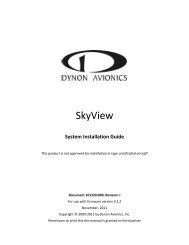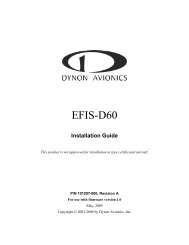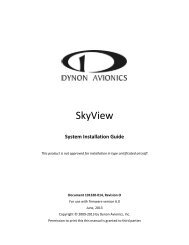EFIS-D100 Installation Guide - Dynon Avionics
EFIS-D100 Installation Guide - Dynon Avionics
EFIS-D100 Installation Guide - Dynon Avionics
You also want an ePaper? Increase the reach of your titles
YUMPU automatically turns print PDFs into web optimized ePapers that Google loves.
5. DSAB CONFIGURATION<br />
This section introduces some concepts that are central to understanding and configuring a<br />
network of DSAB-capable <strong>Dynon</strong> products. It then takes you through a series of simple steps to<br />
configure your network, enabling data sharing and HS34 functionality. Do not proceed with<br />
DSAB configuration until you perform all installation, calibration, and configuration steps for<br />
each instrument with a display. Display-less instruments – such as the HS34 – cannot be fully<br />
configured until DSAB is active, although their physical and electrical installation should be<br />
complete.<br />
Network Concepts<br />
A few concepts must be<br />
understood before<br />
configuring a DSABconnected<br />
system. The<br />
most important is that of<br />
<strong>Dynon</strong> products as<br />
providers of functions to<br />
the network. These<br />
various functions are<br />
called roles. Some<br />
products, such as the<br />
HS34, only have one role<br />
on the network; other<br />
products can provide<br />
multiple roles at a time.<br />
When a device has been<br />
assigned to provide a role<br />
to the network, no other<br />
device on the network can<br />
provide that role at the<br />
same time.<br />
Assignable<br />
roles by<br />
product<br />
<strong>EFIS</strong>-D10A/<br />
<strong>EFIS</strong>-<strong>D100</strong><br />
EMS-D10/<br />
EMS-D120<br />
FlightDEK-<br />
D180<br />
HS34<br />
Bus Master X X<br />
<strong>EFIS</strong> X X<br />
EMS X X<br />
OAT X X X<br />
Compass X X<br />
HS34 X<br />
Autopilot X X<br />
AP Control<br />
Panel<br />
AP<br />
Roll/Pitch<br />
Servo<br />
The table at right lists all available roles and the products which they can be assigned to. Again,<br />
each role can be assigned to no more than one device on the network.<br />
Another important concept is that of the Bus Master. A DSAB-connected network must have at<br />
least one <strong>EFIS</strong>-based product (<strong>EFIS</strong>-D10A, <strong>EFIS</strong>-<strong>D100</strong>, or FlightDEK-D180), and only an <strong>EFIS</strong>based<br />
product can be assigned the Bus Master role. The Bus Master is the instrument which<br />
manages communication on the network. Additionally, if Autopilot servos are installed, the Bus<br />
Master is the Autopilot. While the Autopilot can be controlled from slave devices, if the Bus<br />
Master is not present, the Autopilot will not function. If the Bus Master is turned off or fails, all<br />
data sharing ceases, causing units to display internally-derived data only. When you first perform<br />
DSAB network configuration on an <strong>EFIS</strong>-based instrument, that device is automatically assigned<br />
the Bus Master role. Perform DSAB configuration on your primary <strong>EFIS</strong>-based instrument, as<br />
the Bus Master is also the default provider for both the <strong>EFIS</strong> and Compass roles.<br />
SV32/42/52<br />
X<br />
AP74<br />
X<br />
<strong>EFIS</strong>-<strong>D100</strong> <strong>Installation</strong> <strong>Guide</strong> 5-1
















